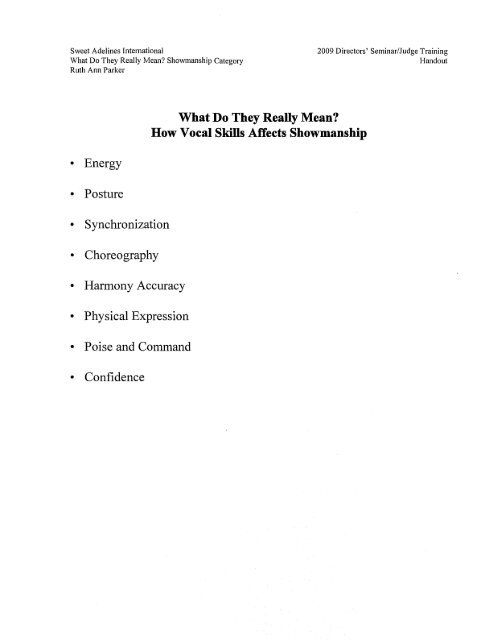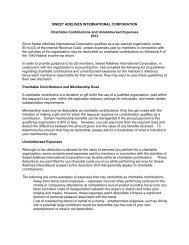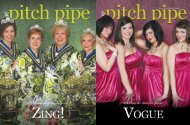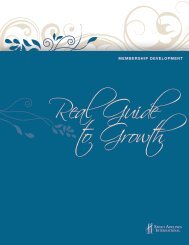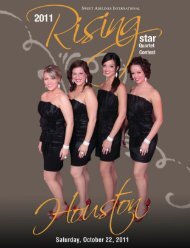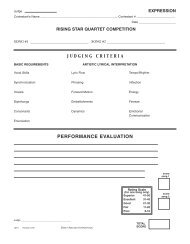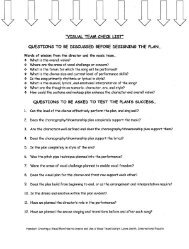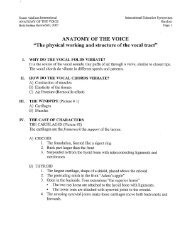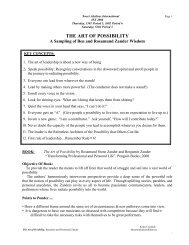judging criteria - Sweet Adelines International
judging criteria - Sweet Adelines International
judging criteria - Sweet Adelines International
You also want an ePaper? Increase the reach of your titles
YUMPU automatically turns print PDFs into web optimized ePapers that Google loves.
<strong>Sweet</strong> <strong>Adelines</strong> <strong>International</strong><br />
What Do They Really Mean? Showmanship Category<br />
Ruth Ann Parker<br />
2009 Directors' Seminar/Judge Training<br />
Handout<br />
What Do They Really Mean?<br />
How Vocal Skills Affects Showmanship<br />
• Energy<br />
• Posture<br />
• Synchronization<br />
• Choreography<br />
• Harmony Accuracy<br />
• Physical Expression<br />
• Poise and Command<br />
• Confidence
Judge J1;,.AtJ<br />
SHOWMANSHIP<br />
Contestant's Name -~'7=-r--~~-----.::..I!£-"-'...::./~-,---f_-L._~-_/_- _ Contestant # -" ~ ~<br />
Contest: Region # Chorus Region # Quartet Date -------~-l.<br />
o Int'I Quartet Semifinals 0 Int'l Chorus Semifinals 0 Int'l Quartet Finals 0 Int'l Chorus Finals 0 Harmony Classic<br />
JUDGING CRITERIA<br />
PERFORMANCE (0-70 points) PREPARATION (0-30 point~ ~'! d I<br />
COMMUNICATION OF THE VISUAL PLAN --t!tM //UL~ , d2{,.-C-<br />
VISUAL AND MUSICAL PRODUCT<br />
'<br />
• /1 ", j) / ':i:' -.v-; ~ .,f~
Judge<br />
SHOWMANSHIP<br />
Contestant's Name ~' ~ontestant # ~<br />
Contest: Region # c:2f Chorus Region # Quartet Date -----=t'.-~ ..1IIIIao<br />
Int'I Quartet Semifinals 0 Int'I Chorus Semifinals 0 Int'l Quartet Finals 0 Int'l Chorus Finals<br />
o Harmony Classic<br />
PERFORMANCE (0-70 points)<br />
COMMUNICATION OF THE<br />
VISUAL AND MUSICAL PRODUCT .<br />
JUDGING<br />
Vocal Skills till?:)p-;Yj(.;fJcl!/%Zt..;>'ctI<br />
Energy ..... ~q!.J. tJ-l.l.C, .'<br />
Poise and comma;2d~L/c..t. /J;t~,u, ?·r:;JL.d: d./"C"<br />
Entrance/?re~k/exit~a.j',".Z;:'..-.tL';I':Li'. __.J...j!.. ;'1/1 _~Li:itZ:L<br />
Char~ctenzatlon . ffiU-~·:,e...- e-tfl4rZ4''?-J:.t2"..;t:'<br />
Physical ExpreSSion '0i .,<br />
Choreography ~t~l/l;{."t./f)!tttl £tf:,,#e12./"-tPJ,.;;;et2
Judge<br />
~h. ,.<br />
;lti/c!t/V<br />
Contestant's Nam%.<br />
Contest: Region #<br />
o Int'I Quartet Semifinals<br />
I<br />
SHOWMANSHIP<br />
y :Contestant # --=----'~<br />
Region # Quartet Date -----~------:'!IlIoIIIILo<br />
Int'l Chorus Semifinals 0 Int'I Quartet Finals 0 Int'l Chorus Finals<br />
o Harmony Classic<br />
JUDGING<br />
CRITERIA<br />
PREPARATION ~O-:3 poin»,». _ -hi' J, dt, :J /)dL<br />
VISUAL PLAN - WI." ~~):.t9~ t/d~~ / {b'--<br />
.. hC.L/<br />
Entrance/break/e it t/JI d- ~t/.~<br />
costum~~~C..e. q/}..ee4c/ a
<strong>Sweet</strong> <strong>Adelines</strong> <strong>International</strong><br />
What Do They Really Mean? Showmanship Category<br />
Ruth Ann Parker<br />
2009 Directors' Seminar/Judge Training<br />
Handollt 2<br />
WHAT DO THEY REALLY MEAN? - SHOWMANSIDP<br />
30% PORTION OF SHOWMANSHIP CATEGORY<br />
THE MOST COMMON QUESTIONS ASKED<br />
COSTUMING:<br />
MAKEUP:<br />
GROOMING:<br />
DESIGN<br />
THE FIT<br />
MIDRIFF AREA<br />
UNDERGARMENTS<br />
SUITABILITY TO THE PERFORMER<br />
COLOR<br />
NO RULES TO WHAT KIND OF MAKEUP USED<br />
FULL COVERAGE<br />
NATURAL LOOK IS DEFINITELY NOT APPROPRIATE<br />
LIPSTICK COLOR<br />
EYE SHADOWS<br />
FALSE EYELASHES<br />
BLUSH - BLEND, BLEND, BLEND<br />
FINGER NAIL POLISH<br />
WRINKLES<br />
BE RELENTLESS<br />
UNITY ACROSS THE CHORUS BOTH MAKEUP & GROOMING<br />
HAIRSTYLES<br />
An excellent way to prepare for performing on stage, under bright stage lights are, invest in a<br />
strip ofstage lights (ifpossible). Have each singer get a "pass" just as we do in our music.<br />
Stand in front ofthose lights and make sure all bases are covered. Allow time for each singer to<br />
be checked before performing on the contest stage.<br />
Our Showmanship Judges are paying attention to this side ofthe category. Don't give away<br />
those points.<br />
Just remember that you are the seed to your chorus's energy. If you have confidence in them,<br />
they will in turn give it back to you. Ifeach and every singer looks professional and confident,<br />
they will sing better and the overall results will pay great dividends.
<strong>Sweet</strong> <strong>Adelines</strong> <strong>International</strong><br />
What Do They Really Mean? Music CategOly<br />
Carolyn Healey<br />
MUSIC CATEGORY<br />
2009 Directors' Seminar/Judge Training<br />
Outline<br />
I. Difference between strong song/arrangement and suitability to performer<br />
1. Music choice on the 30% section greatly affects the 70% section<br />
2. A song can be strong yet not suitable to the performer because it is too difficult.<br />
II.<br />
III.<br />
70% PERFORMANCE - Subheadings self-explanatory<br />
A. Vocal Skills<br />
B. Harmony Accuracy<br />
C. Barbershop Style (Tempo, Rhythm, Musical Unity, Phrasing, Dynamics, Musical<br />
Energy)<br />
D. Musical Artistry<br />
30% SONG & ARRANGEMENT-most confusion lies in this area<br />
A. Song<br />
1. Based on Circle ofFifths<br />
2. Major Mode<br />
Strong chords: Major Triad; Barbershop 7 th ; Barbershop 9 th<br />
Secondary chords: Major 6 th ; Major i h ; Major 9 th ; Minor Triad; Minor 6 th ;<br />
Minor i h ; Diminished; Augmented<br />
3. Should not have very wide or awkward intervals in melody<br />
4. YOU ARE MY SUNSHINE -weak because it is stanzaic in form-masterful<br />
arrangement: Exhibit #1<br />
5. Song requiring many secondary chords: Exhibit #2<br />
How a weak song may score in A- range<br />
Weak secondary chord should not fall on important pali ofsong<br />
B. Form<br />
1. Intro: should be 4 or 8 measures (ifthere is one)<br />
2. Verse: 8 or 16 measures (ifthere is one)<br />
3. Chorus: MUST have 8 measure increments for full 32 measures. It may have<br />
last 8 or 16 measures repeated.<br />
4. Tag: in increments of4 measures<br />
5. Ballad has implied meter<br />
6. 4-bar increments-cannot add beats: Exhibit #3<br />
7. Medleys have same rules as single song<br />
C. Voicing<br />
1. Can be too high, too low or too spread - know capability ofchorus members<br />
2. An-angements for Male Voices vs. Female Voices<br />
Usually music for females is voiced a fourth lower when transposing from<br />
music for male voices but may be too spread<br />
Often can be adapted by switching tenor and baritone in places<br />
Music for male voices: baritone mostly above lead<br />
Music for female voices: baritone mostly below lead<br />
D. Harmonization<br />
1. Must follow implied harmony ofmelody<br />
2. Cannot substitute strong chords for weak chords
MUSil<br />
~:~::::~n~:g~:;: Chorus Region # Quartet contestan~:te---,ttt<br />
Judge<br />
o Int'I Quartet Semifinals 0 InVI Chorus Semifinals 0 Int'l Quartet Finals 0 Int'l Chorus Finals 0 Harmony Classi<br />
SONG & ARRANGEMENT (0-30 points)<br />
Merit as Barbershop Material<br />
~Melody/Lyrics tt:k-,,1n1// J..,<br />
JUDGING<br />
A /,~ 7/Uff;l<br />
~ngement "i1!#-fAP'7J~?V{/~j!: '4~<br />
Harmonization ~r I fPtJ:<br />
Voicing<br />
CRITERIA<br />
PERFORMANCE (0-70 points)<br />
Vocal Skills P-t¥~ ,L,A:'<br />
Harmony Accuretty~ lJ....-n..U<br />
Barbershop Style .. '~~ _,7,<br />
'tLu/it:<br />
Tempo-#J,. a; 1M 0-"-.-<br />
.b4},<br />
Rhythm - jJ/t/f/ff./<br />
Musical UnityJ~#<br />
Phrasing f'~<br />
Dynamics<br />
Musical Energy<br />
Musical Artistry<br />
iVkl/<br />
(J~' I (<br />
PERFORMANCE EVALUATION<br />
SONG #1 ~! Ittt ~~ SONG #2 ~ 12i'#tv~<br />
score<br />
song 1<br />
~~~~~~~~~~~@J<br />
94 - 100 A+<br />
86 - 93 A<br />
80 - 85 A-<br />
74 - 79 B+<br />
66 - 73 B<br />
60 - 65 B-<br />
54- 59 C+<br />
46 - 53 C<br />
40- 45 C-<br />
34- 39 D+<br />
26 - 33 D<br />
20- 25 D-<br />
O - 19 F<br />
Bonus Points<br />
awarded for<br />
performance<br />
package.<br />
<strong>International</strong> Finals<br />
and Harmony<br />
Classic only.<br />
score<br />
[ZB<br />
BONUS<br />
POINTS<br />
D<br />
JSS-1 Revised 5/02 SWEET ADELINeS INTERNATIONAL
Judge<br />
Contestant's Name Contestant # ----::3<br />
Contest: Region # Chorus Region # Quartet Date _---,...<br />
o Int'l Quartet Semifinals 0 Int'l Chorus Semifinals 0 Int'l Quartet Finals 0 Int'l Chorus Finals assi<br />
SONG & ARRANGEMENT (0-30 points)<br />
Merit as Barbershop Material<br />
JUDGING<br />
Form/MelOdY/LyriCS. . ~<br />
Arrangement<br />
'<br />
~~~~n~nizat~J. L,.h11v1f/<br />
C/.. '4fJt1 11<br />
OVIIWd<br />
CRITERIA<br />
PERFORMANCE (0-70 point~l .•<br />
Vocal Skills '-/(jw JU/1/f({# .<br />
Harmony Accur~lY.-;uH~<br />
Barbershop Style , ://1.----<br />
Tempo...-tJtUf./Alv<br />
Rhythm<br />
~v1teeL<br />
Musical Unity<br />
Phrasing ~<br />
Dynamics ~<br />
Musical Energy<br />
Musical Artistry/}litt£<br />
SONG #1<br />
PERFORMANCE EVALUATION<br />
~~~ ~ SONG #2 .~t 1f6''iAL:fiuu:<br />
....)'ia'2U.~~~~::::)'£iJ.~~~~~@~~~~(£j~~':l£.~~~~t:1:.L'U'f2.L~tff:.~~~V<br />
song 1<br />
~~~~~~~~-[W<br />
score<br />
SCORING LEVELS<br />
(for one song)<br />
SUITABILITY TO PERFORMER<br />
Song 1<br />
\iir~fv~~1WJu<br />
I<br />
J"dgeta¥~<br />
Song 2<br />
94 - 100 A+<br />
86 - 93 A<br />
80 - 85 A-<br />
74 - 79 B+<br />
66 - 73 B<br />
60- 65 B-<br />
54- 59 C+<br />
46 - 53 C<br />
40 - 45 C-<br />
34- 39 D+<br />
26 - 33 D<br />
20- 25 D-<br />
O - 19 F<br />
Bonus Points<br />
awarded for<br />
performance<br />
package.<br />
<strong>International</strong> Finals<br />
and Harmony<br />
Classic only.<br />
score<br />
GtJ<br />
BONUS<br />
POINTS<br />
D<br />
JSS-1 Revised 5/02<br />
SWEET AOELINES INTERNATIONAL<br />
TOTAL<br />
SCORE<br />
I<br />
91 I
Judge<br />
Contestant's Name-----------------Contestant #<br />
~'i..2<br />
Contest: Region # Chorus Region # Quartet Date ~ . ~ illo<br />
Int'l Quartet Semifinals 0 Int'I Chorus Semifinals 0 Int'l Quartet Finals 0 Int'l Chorus Final~ .. ~armony Classi<br />
JUDGING<br />
SONG & ARRANGEMENT (0-30 points)<br />
Me;it, as Barbershop Material<br />
;R;;rJMeIOdy/Lyricsjf;L- ,- 1;./<br />
~~gement<br />
Ha.r~onizationaiJ.r1<br />
Ji1t<br />
prt'!:U ,/llt/<br />
VOICIng YbIJfJ1//;, }fMlJt<br />
f<br />
·11.tjJ[pv~<br />
CRITERIA<br />
PERFORMANCE (0-7fJ p.?iJl~~) .. A)<br />
Vocal Skills ..U!'Iwt ~se;A//I,;/frJ?-P<br />
Harmony Accuracy~t (c-v ~ ~ r'-<br />
Barbershop Style<br />
Tempo<br />
Rhythm<br />
Musical Unity/<br />
Phrasing V/<br />
Dynamics V<br />
Musical Energy11..ttd J"J'LI-1f/<br />
Musical Artistry~1'~rtf/<br />
PERFORMANCE EVALUATION<br />
SONG#l~r:R~YlLttJtHd SONG#2 d(;ff
<strong>Sweet</strong> <strong>Adelines</strong> <strong>International</strong><br />
What Do They Mean? Expression Category<br />
Paula Davis<br />
2009 Directors' Seminar/Judge Training<br />
Handout<br />
Page 1 of 3<br />
What Do They Mean...?<br />
Expression<br />
1. Musicality - "a sensitivity to, knowledge of, or talent for music"<br />
"the quality or state of being musical"<br />
**The presence of musicality in the performance<br />
indicates not only a technically excellent<br />
performance, but also reveals the performer's<br />
sincere relationship with the lyrical and musical<br />
message and the courage to be vulnerable with the<br />
audience in delivering it.<br />
Creating and Producing Musicality<br />
(not an exhaustive list!)<br />
1. Legato, vowel to vowel singing<br />
2. Synchronization clarity<br />
3. In-Tune Singing<br />
4. Effective breath management and forward<br />
motion<br />
5. Unity and Sincerity in the plan delivery<br />
6. Energy<br />
Distractions from Musicality<br />
(not an exhaustive list either. .. )<br />
1. Choppiness<br />
2. Frequent Synchronization Errors<br />
3. Out of Tune Singing<br />
4. Lack of Effective Dynamic Delivery (or<br />
other artistic elements)<br />
5. Inadequate vocal skills for the creative plan<br />
6. Lack of unified energy
<strong>Sweet</strong> <strong>Adelines</strong> <strong>International</strong><br />
What Do They Mean? Expression Category<br />
Paula Davis<br />
2009 Directors' Seminar/Judge Training<br />
Handout<br />
Page 2 of 3<br />
2. Forward Motion - "to help onward, promote, send forward"<br />
**When forward motion is present, lyrical messages<br />
are propelled with energy and intent providing a<br />
dramatic and exciting experience for the listener. If<br />
forward, motion is not present, attention is drawn to<br />
the things present in the delivery other than the<br />
overall story. Even if the technique is good, the<br />
objective is to tell a stOry.<br />
Employing Forward Motion<br />
1. Energy!<br />
2. Consistent air flow and breath<br />
management and breathing techniques<br />
3. Legato, vowel to vowel delivery<br />
4. Lifted phrase endings<br />
5. Meaningful, creative lyrical plans<br />
developed from the lyrical intent (not just to<br />
show off the technical abilities)<br />
Obstacles to Forward Motion<br />
1. Loss of effective breath support or breath<br />
management<br />
2. Inadequate vocal skills for the lyrical<br />
demands<br />
3. Lack of energy<br />
4. Over enunciation<br />
5. Unclear understanding the dramatic intent<br />
of the lyrical message<br />
3. Emotional Communication - "projecting a sentiment<br />
appropriate to the message and producing an emotional<br />
response within the listener"<br />
**Emotional communication occurs only when the<br />
performer demonstrates skill in the "basic<br />
requirements" and performs with freedom, passion
<strong>Sweet</strong> <strong>Adelines</strong> <strong>International</strong><br />
What Do They Mean? Expression Category<br />
Paula Davis<br />
2009 Directors' Seminar/Judge Training<br />
Handout<br />
Page 3 of 3<br />
and a complete commitment to the lyrical and<br />
musical message.<br />
Emotional Communication Exhibits:<br />
1. A sincere, intense emotion projected to the<br />
audience through an artistic, lyrical<br />
interpretation producing a response in the<br />
listener<br />
2. Emotion and delivery appropriate to the<br />
song and the barbershop style<br />
3. Mastery of the basic requirements of the<br />
expression category<br />
4. Mastery of the artistic elements of the<br />
category - word delivery, inflection,<br />
finesse, phrasing, dynamics, tempo/rhythm<br />
Inhibitors to Emotional Communication<br />
1. Emotional message unclear and/or not<br />
unified<br />
2. Lack of intensity and energy to send the<br />
emotion to the audience<br />
3. Unexplored or under-developed use of<br />
artistic elements<br />
4. Insufficient vocal skills to deliver the<br />
creative plan effectively<br />
5. Focusing on anything other than reaching<br />
the audience with the lyrical and musical<br />
message<br />
When a performance has complete command of all the technical<br />
elements of singing and then adds true emotional communication,<br />
making the audience unaware it is hearing anything other than a<br />
beautiful song, straight from the heart, the performers have achieved<br />
the ultimate in this category - true musical expression.<br />
Excerpts from the Judging Category Description Book, available to every <strong>Sweet</strong> Adeline<br />
performer
Judge<br />
Contestant's Name<br />
.~XPRESSIO<br />
Contestant #~er<br />
Contest: Region # Chorus Region # Quartet Date J._r---<br />
o Int'I Quartet Semifinals 0 Int'I Chorus Semifinals 0 Int'I Quartet Finals 0 Int'l Chorus Finals 0 Harmony Class<br />
BASIC REQUIREMENTS (0-40 points)<br />
Vocal Skills<br />
Synchronization<br />
Vowels<br />
Diphthongs<br />
Consonants<br />
Enunciation<br />
JUDGING<br />
CRITERIA<br />
ARTISTIC LYRICAL INTERPRETATION (0-60 points)<br />
Lyric Flow<br />
Phrasing..<br />
Forward Motion<br />
Embellishments<br />
Dynamics<br />
Tempo/Rhythm<br />
Inflection<br />
Energy<br />
Finesse<br />
Emotional Communication<br />
PERFORMANCE EVALUATION<br />
SONG #1 Wi 1/ If t3e ).1 e, SONG #2 --------------<br />
)v1 {,{.::; ('(!.a-((+j --<br />
I<br />
JSS-1 Revised 5/02 SWEET ADELINES (NTERNATIONAL<br />
Bonus Points<br />
awarded for<br />
performance<br />
package.<br />
<strong>International</strong> Finals<br />
and Harmony<br />
Classic only.<br />
TOTAL<br />
!=:r.m:u=<br />
I<br />
BONUS<br />
POINTS<br />
D
JSS-1 Revised 5/02 SWEET AOELINES INTERNATIONAL<br />
Judge<br />
EXPRESSIOI<br />
Contestant's Name Contestant #--#~ _<br />
Contest: Region # Chorus Region # Quartet Date .... =----==--__<br />
o Int'l Quartet Semifinals 0 Int'l Chorus Semifinals 0 Int'l Quartet Finals 0 Int'I Chorus Finals 0 Harmony Classil<br />
BASIC REQUIREMENTS (0-40 points)<br />
Vocal Skills<br />
Synchronization<br />
Vowels<br />
Diphthongs<br />
Consonants<br />
Enunciation<br />
JUDGING<br />
CRITERIA<br />
ARTISTIC LYRICAL INTERPRETATION (0-60 points)<br />
Lyric Flow<br />
Phrasing..<br />
Forward Motion<br />
Embellishments<br />
Dynamics<br />
Tempo/Rhythm<br />
Inflection<br />
Energy<br />
Finesse<br />
Emotional Communication<br />
PERFORMANCE EVALUATION<br />
SONG #1 .J6 c;@u Lo= fI"i fiknc/j 0>u-e.-SONG #2 _~<br />
_<br />
SCORING LEVELS<br />
(for one song)<br />
94 - 100 A+<br />
86 - 93 A<br />
80- 85 A-<br />
74 - 79 B+<br />
86 - 73 B<br />
60- 65 B-<br />
54- 59 C+<br />
46 - 53 C<br />
40- 45 C-<br />
34- 39 D+<br />
26 - 33 D<br />
20 - 25 D-<br />
O - 19 F<br />
Bonus Points<br />
awarded for<br />
performance<br />
package.<br />
<strong>International</strong> Finals<br />
and Harmony<br />
Classic only.<br />
score<br />
DBONUS<br />
POINTS<br />
D
Judge<br />
EXPRESSIO<br />
_<br />
Contestant's Name __.,.----------~-__.,.-----Contestant #~::!<br />
Contest: Region # Chorus Region #. Quartet Date ~<br />
o Int'l Chorus Finals 0 Harmony Classi<br />
o Int'I Quartet Semifinals 0 Int'l Chorus Semifinals 0 Int'l Quartet Finals<br />
BASIC REQUIREMENTS (0-40 points)<br />
Vocal Skills<br />
Synchronization<br />
Vowels<br />
Diphthongs<br />
Consonants<br />
Enunciation<br />
JUDGING<br />
CRITERIA<br />
ARTISTIC LYRICAL INTERPRETATION (O~60 points)<br />
Lyric Flow<br />
Phrasing..<br />
Forward Motion<br />
Embellishments<br />
Dynamics<br />
Tempo/Rhythm<br />
Inflection<br />
Energy<br />
Finesse<br />
Emotional Communication<br />
PERFORMANCE EVALUATION<br />
SONG #1 U)ha-f \(I r b; SONG #2 --------------<br />
score<br />
JSS-1 Revised 5/02 SWEET AOELINES INTERNATIONAL<br />
Bonus Points<br />
awarded for<br />
performance<br />
package.<br />
<strong>International</strong> Finals<br />
and Harmony<br />
Classic only.<br />
TOTAL<br />
~f"".no~<br />
I<br />
oBONUS<br />
POINTS<br />
D
<strong>Sweet</strong> <strong>Adelines</strong> <strong>International</strong><br />
What Do They Really Mean? Sound Category<br />
Sharon Babb<br />
2009 Directors' Seminar/Judge Training<br />
Handollt<br />
Page #1<br />
WHAT DO THEY REALLY MEAN?<br />
Sound Category<br />
The focus ofthe sound category is the evaluation ofUNIT SOUND in the<br />
BARBERSHOP STYLE. Unit sound occurs when tones are properly<br />
produced, accurately tuned, blended, and balanced. In barbershop<br />
terminology, this is referred to as "LOCK AND RING." Although the<br />
sound judge does not evaluate vocal technique in and ofitself, the sound<br />
category does include evaluation ofthe basics of CORRECT SINGING.<br />
Reasonable proficiency in the basics ofcorrect singing must be achieved<br />
before the performer's effOlis in any ofthe four categories will be totally<br />
successful.<br />
The judge rewards a performance wherein:<br />
All singers consistently apply techniques ofgood vocal production.<br />
Total accuracy exists both horizontally within individual part lines and<br />
vertically within individual chords.<br />
Vocal qualities are blended both within chorus sections and within the<br />
overall qumiet or chorus unit, culminating in a composite, well-produced<br />
musical sound.<br />
Cone-shaped balance ofvoices or sections is maintained.<br />
Overall application ofvocal and stylistic technique enhances the identifiable<br />
chm"acteristics ofthe barbershop style, resulting in a musical performance in<br />
the sound category.<br />
Finally, the sound judge seeks a musical sound that draws the audience out<br />
oftheir daily experiences into a world ofjoy and exhilaration. Beautiful<br />
sounds, correctly produced and expressed from the heart, create an enduring<br />
musical experience and surely prove the greatest showcase for the<br />
barbershop style ofmusic.


